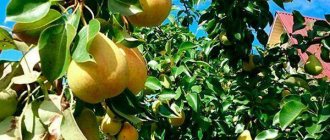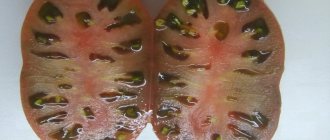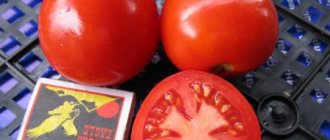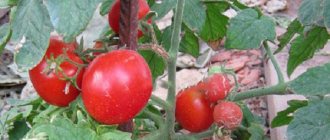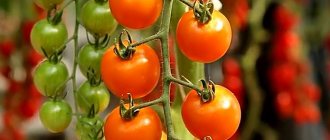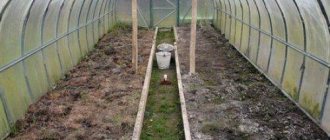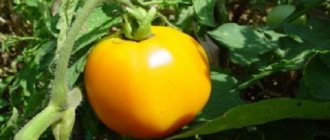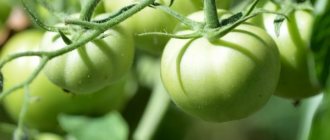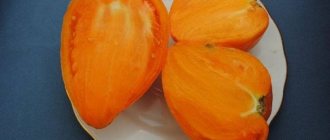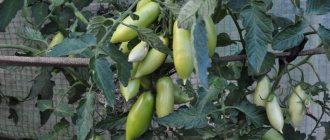Tomato Yellow Scallops is liked by everyone without exception, and especially by children and tomato gourmets. The fruits contain a high level of carotenes, vitamins, and minerals, which is why they are used in dietary nutrition and are also included in the baby’s diet.
| Height | Landing location | Ripening time | Fruit color | Fruit size | Origin | Fruit shape |
| Tall | Greenhouse, Open ground | Mid-early | Yellow | Large | Variety | With spout |
Description of the variety
- Ripening period: medium-early;
- Height: indet, 160-180 cm, formed into 2-3 stems;
- Fruit color: bright yellow;
- Fruit weight: 200-500 g;
- Fruit shape: heart-shaped with a spout;
- Purpose: fresh consumption, juices, dietary and baby food;
- Sheet type: regular thin;
- Place of cultivation: OG, greenhouse;
The taste of tomatoes is excellent, very sweet, the flesh is white-yellow, granular, and there are pink veins on the cut. Super variety! High yield. Ripening period - mid-early (ripening period 100-110 days). The bush is indeterminate (up to 1.8 m), medium-leafy.
Universal purpose. Designed for growing in open ground and under film covers. The fruits are medium and large in size (weighing 200-400 g), heart-shaped, often with a spout, smooth, glossy, bright yellow in color, with dense pink-striped pulp, sweet taste.
The variety is high-yielding, light-loving, drought-resistant, resistant to most diseases, unpretentious to growing conditions, and only requires fertilizing. Plants need garter and supports. The fruits do not crack, are well stored, and tolerate transportation well.
The variety is recommended to be grown in a greenhouse. To get maximum yield, you need to leave only 2 stems on one bush. Ripe heart-shaped vegetables with an orange tint, as in the photo. The flesh with pink veins is very sweet. Scallops are readily eaten and tomato juice is made from them. They are not suitable for processing or conservation.
tomatland.ru
Very tasty and healthy tomato - Yellow scallops: variety description and growing tips
Golden stream
The tomato is deservedly called ultra-early ripening. According to the characteristics of the variety, the first ripe fruits appear 82 days after sowing. The peculiarity is the uniform ripening of all tomatoes in a short time. According to the description, the bushes are literally strewn with golden-colored ellipsoidal tomatoes from top to bottom. They have a pleasant taste, are suitable for preservation, and have a hard skin.
Golden Koenigsberg
Tomatoes are large in size, elongated in shape. The taste of the pulp is sweet with an apple flavor. With careful care, up to three buckets of harvest can be harvested from one bush.
Firebird
The round hybrid belongs to the category of vegetables with early ripening. This yellow tomato is not suitable for canning, but the raw fruits are simply wonderful. They make delicious juice. Tomatoes keep for a long time at room temperature.
The yield from one square meter, which is 6 bushes, is up to 13 kg.
Yellow ball
The variety is suitable for cultivation in central Russia. He is not afraid of sudden and significant temperature changes. The yield is not that high, but careful gardeners do not get less than 3 kg of fruit from one bush, and the “balls” do not ripen simultaneously, but throughout the entire season.
The variety is unusually tasty, and because of this property it is readily grown. Yellow tomatoes last a long time at room temperature.
Giant
Very large tomatoes are flattened or round in shape. They remain for a long time after removal. The taste is sweet. Giant tomatoes make very good condiments, ketchups, and sauces.
Honey Spas
Orange tomatoes with large heart-shaped fruits. The taste of the pulp is sweet with a slight sourness.
Tiny cherry tomatoes taste great. The pulp of the fruit is unusually aromatic and sweet. They grow in clusters. Up to 60 tomatoes are formed on one brush.
Yellow tomatoes are all good and no harm! The growing features are the same as for any tomatoes. Before planting them in open ground, make sure that the varietal variety is suitable for the climate of your area.
Olga Danilina
We invite you to familiarize yourself with hazel seedlings grafted onto bear nuts
This year I decided to plant new tomatoes. In the summer we were at the dacha, and a neighbor treated us to tomatoes. Such cool ones. I usually had a hard time getting the kids to eat the salad; they only chewed cucumbers in any form, but here they seemed to fall apart. In 2 days, half a bucket was ground. I was even afraid that things would get worse.
We agreed that my neighbor would grow the seedlings for me, and I would just buy the seeds. The tomato has such an interesting name: “Yellow Scallops”. Its shape really looks like a comb. Some fruits are stronger, while others are weaker. And the color is generally cool. It is so yellow that it seems to glow from within.
The only bad thing is that they are greenhouse, and even indeterminate. You have to tie it up and pin it down.
Description of the variety
- Ripening period: medium-early;
- Height: indet, 160-180 cm, formed into 2-3 stems;
- Fruit color: bright yellow;
- Fruit weight: 200-500 g;
- Fruit shape: heart-shaped with a spout;
- Purpose: fresh consumption, juices, dietary and baby food;
- Sheet type: regular thin;
- Place of cultivation: OG, greenhouse;
The taste of tomatoes is excellent, very sweet, the flesh is white-yellow, granular, and there are pink veins on the cut. Super variety! High yield. Ripening period - mid-early (ripening period 100-110 days). The bush is indeterminate (up to 1.8 m), medium-leafy.
The variety is high-yielding, light-loving, drought-resistant, resistant to most diseases, unpretentious to growing conditions, and only requires fertilizing. Plants need garter and supports. The fruits do not crack, are well stored, and tolerate transportation well.
The variety is recommended to be grown in a greenhouse. To get maximum yield, you need to leave only 2 stems on one bush. Ripe heart-shaped vegetables with an orange tint, as in the photo. The flesh with pink veins is very sweet. Scallops are readily eaten and tomato juice is made from them. They are not suitable for processing or conservation.
The fruits are heart-shaped, often with a large spout, smooth, yellow-orange in color at maturity, weighing 200–500 grams, sweet, very tasty. Not prone to cracking. The pulp is white-yellow, granular, often with pink streaks. These tomatoes are good for fresh consumption and making juice. Recommended for children's and dietary nutrition.
Sowing seeds for seedlings is carried out 60–65 days before planting in the ground. When planting seedlings in a permanent place per 1 sq. m place up to 4 plants.
Your reviews of the Yellow Scallops tomato and additions to the description will help many tomato lovers evaluate this variety objectively and decide whether it is worth planting or not.
Tomatoes of the Yellow Scallop variety have excellent yields, which is why they are of interest to many summer residents and gardeners. It is believed that from one tomato bush you can get up to 4 or more kg of fruit. This is only possible if you follow the growing technique and properly care for the plants.
The main advantages of the Yellow Scallops tomato variety are:
- High yield of tomatoes.
- Easy to grow and care for.
- Plants are not afraid of temperature changes.
- Tomatoes have excellent taste.
- The fruits are large, fleshy, juicy. They tolerate transportation well and do not crack.
- Due to its good taste, the vegetable is used for making juice, salads, first and second courses. Also good fresh.
- Tomatoes are low in calories and contain quite a lot of useful components.
We invite you to familiarize yourself with calla lilies agricultural technology
The plant has some resistance and good immunity to major dangerous diseases. Among the disadvantages of the Yellow scallop tomato, the plant is tall, which makes further care difficult and increases the risk of damage to the bush under unfavorable weather conditions.
Mid-season tomato variety Yellow scallops are grown using the traditional method, like other tomatoes. Planting is carried out approximately 60-65 days before the intended planting of seedlings in open ground or a greenhouse.
Next, the substrate is distributed into containers and plastic containers. It is advisable to choose containers with small holes at the bottom to ensure the necessary gas exchange and avoid stagnation of liquid.
Note! Tomato seeds of the Yellow Scallop variety are planted in mid- or late March, so that seedlings can be planted in early or mid-June.
The next step is planting the seeds. To do this, the soil in the prepared containers is thoroughly moistened. Afterwards, shallow furrows are made and seeds are immersed in them infrequently. The top is covered with soil. To speed up the germination of sprouts, containers with plantings can be covered with polyethylene. Thus, optimal humidity, temperature and light will be formed for the plants.
As soon as the seedlings have grown sufficiently and the temperature outside is warm, they are transplanted into open ground or a greenhouse. To do this, the ground is first dug up and the necessary fertilizers are added in the form of mineral and organic compounds.
Shallow holes are dug along the entire perimeter of the site. They should be slightly moistened. The seedlings are immersed in the ground to almost half its length or to the level of the first leaves. Cover the top with soil and compact it a little. Then the plantings are watered.
To make the bush stronger and not break as a result of the wind and under the influence of large fruits, it is advisable to form it into 2 or 3 stems.
Caring for any plants is an integral part of a rich harvest. Therefore, proper watering, timely cultivation, and control of weeds, diseases and pests will help to achieve high plantings. As well as loosening the soil, applying fertilizers and mulching the plant.
On hot days, watering can be done up to 2 times; during the rainy period, the plants are not watered to prevent disease and rotting. After watering, the tomatoes must be weeded and the holes loosened.
Mulching is carried out every 2 weeks. Also, the Yellow Scallops tomato should be staked because it grows tall. Harvesting is carried out as needed. It is advisable not to delay this so that the fruits do not become overripe, because they will not be stored well.
Tomatoes are fertilized at least 3 times during the entire period of plant growth. For this purpose, mineral and organic fertilizers are used. For example: superphosphate, wood ash, potassium, nitrogen compounds and other substances.
Diseases and pests are controlled using chemicals that are sprayed on plants. Timely care, proper cultivation and adherence to watering techniques also help prevent diseases.
Diseases and pests
Every vegetable in the garden is susceptible to certain diseases that must be combated. Tomato Yellow scallops have excellent resistance and immunity, but if care is not taken care of and the plantings are not watered correctly, diseases cannot be avoided.
Among the common pests that attack tomatoes are aphids, whiteflies, mole crickets, wireworms and some other insects. Proper plant care, preventative spraying of tomatoes with preparations and planting the plant in the right place will help to avoid their appearance.
Fruit characteristics
The fruits are heart-shaped, often with a large spout, smooth, yellow-orange in color at maturity, weighing 200–500 grams, sweet, very tasty. Not prone to cracking. The pulp is white-yellow, granular, often with pink streaks. These tomatoes are good for fresh consumption and making juice. Recommended for children's and dietary nutrition.
Sowing seeds for seedlings is carried out 60–65 days before planting in the ground. When planting seedlings in a permanent place per 1 sq. m place up to 4 plants.
If you have grown Yellow Scallop tomatoes, please write your impression of this variety. What was the yield and taste of the fruits like under your climatic conditions? If possible, attach a photo of the entire bush or individual fruits of this variety.
Your reviews of the Yellow Scallops tomato and additions to the description will help many tomato lovers evaluate this variety objectively and decide whether it is worth planting or not.
Advantages and disadvantages
Perhaps the most important advantage of these beautiful vegetables is that they are completely safe for people suffering from allergic diseases; this is their difference from red tomatoes. It is important that these are the tomatoes that are used to prepare food for babies. So they are even healthier than red ones.
The pulp contains a lot of vitamin A. It is this fact that determines the color. There is very little acid in them. In addition, vegetables are rich in beta-carotene and lycopene - this trace element removes toxins from the body and suppresses cancer cells. The pulp also contains a fairly large amount of niacinin, which strengthens the walls of blood vessels.
What varieties of yellow tomatoes bear fruit well in our natural conditions? Some of them are preferable to grow in greenhouses, while others are good for the vegetable garden.
The main advantages of the Yellow Scallops tomato variety are:
- High yield of tomatoes.
- Easy to grow and care for.
- Plants are not afraid of temperature changes.
- Tomatoes have excellent taste.
- The fruits are large, fleshy, juicy. They tolerate transportation well and do not crack.
- Due to its good taste, the vegetable is used for making juice, salads, first and second courses. Also good fresh.
- Tomatoes are low in calories and contain quite a lot of useful components.
The plant has some resistance and good immunity to major dangerous diseases. Among the disadvantages of the Yellow scallop tomato, the plant is tall, which makes further care difficult and increases the risk of damage to the bush under unfavorable weather conditions.
ogorod-bez-hlopot.ru sovusadba.ru
Description and characteristics of the variety
The scallop is an indeterminate plant, characterized by abundant harvests and the excellent taste of beautiful scarlet tomatoes. Plump large fruits ripen in medium terms. The first harvest is harvested 118-120 days after germination. Fruiting is uniform, extended until autumn.
Features and characteristics of the variety:
- indeterminate growth;
- the height of the stems varies between 1.6-1.7 m;
- moderate foliage;
- mid-ripening.
Large tomatoes have a wonderful taste - sourness and sweetness are perfectly balanced.
What is the attractiveness of the fruits, their description:
- average weight 200-300 g;
- large lower tomatoes reach 400-500 g;
- scarlet-red color;
- the shape resembles a red comb;
- the flesh is fleshy, moderately juicy;
- The consistency is not watery.
Tomatoes are used for fresh recipes, making Italian-style juices and sauces.
Rules for growing tomatoes
Mid-season tomato variety Yellow scallops are grown using the traditional method, like other tomatoes. Planting is carried out approximately 60-65 days before the intended planting of seedlings in open ground or a greenhouse.
The first step in growing tomatoes is preparing the soil. Sandy loam soil is mainly used for such vegetables. To plant seeds, prepare the substrate yourself or purchase the mixture at a specialized store.
Next, the substrate is distributed into containers and plastic containers. It is advisable to choose containers with small holes at the bottom to ensure the necessary gas exchange and avoid stagnation of liquid.
Note! Tomato seeds of the Yellow Scallop variety are planted in mid- or late March, so that seedlings can be planted in early or mid-June.
The next step is planting the seeds. To do this, the soil in the prepared containers is thoroughly moistened. Afterwards, shallow furrows are made and seeds are immersed in them infrequently. The top is covered with soil. To speed up the germination of sprouts, containers with plantings can be covered with polyethylene. Thus, optimal humidity, temperature and light will be formed for the plants.
Also, before planting, the seeds, if necessary, can be treated with growth preparations. This will ensure quick and friendly germination of seedlings. After growing the seeds, the sprouts are properly cared for. If necessary, moisten the soil, remove weeds and fertilize.
As soon as the seedlings have grown sufficiently and the temperature outside is warm, they are transplanted into open ground or a greenhouse. To do this, the ground is first dug up and the necessary fertilizers are added in the form of mineral and organic compounds.
Shallow holes are dug along the entire perimeter of the site. They should be slightly moistened. The seedlings are immersed in the ground to almost half its length or to the level of the first leaves. Cover the top with soil and compact it a little. Then the plantings are watered.
To make the bush stronger and not break as a result of the wind and under the influence of large fruits, it is advisable to form it into 2 or 3 stems.
The best choice for greenhouses
Pepper-shaped
The hybrid is not devoid of exoticism, but it is grown only in greenhouses. This is due to the fact that the variety is tall, the bushes cannot withstand the winds, and the stems break. The bright small fruits are shaped like an ellipse, and how delicious they are!
Date fruit
Our breeders developed small-fruited tomatoes. The taste is fruity. Summer residents of Central Russia recommend growing it indoors; the vegetables are heat-loving. The height of the bushes reaches one and a half meters.
The stems need to be tied up. Beautiful orange tomatoes ripen towards mid-June. Productivity depends on weather conditions. The hybrid successfully tolerates low temperatures, but the yield is significantly reduced. Dates can be grown right on the windowsill!
Truffle
This is a variety of Japanese truffle. The fruits are equally good fresh or canned. The bush reaches a height of one and a half meters, not higher. The stems need to be tied up and the shoots need to be cut off regularly. A high-yielding tomato bears fruit equally well in greenhouses or in the garden. Externally, the fruits are similar to the truffle mushroom. Their flesh is dense and juicy. Sweet to taste.
Yellow scallops
The variety is recommended to be grown in a greenhouse. To get maximum yield, you need to leave only 2 stems on one bush. Ripe heart-shaped vegetables with an orange tint, as in the photo. The flesh with pink veins is very sweet. Scallops are readily eaten and tomato juice is made from them. They are not suitable for processing or conservation.
Caramel
Hybrid tomato designed for greenhouses. Characterized by high yield and early ripening. The uniqueness of the bush is that each brush holds up to fifty tomatoes, but not immediately, but rather over a long period of time.
The pulp is fleshy, contains little water, and is sweetish. The skin is dense, which allows the crop to be stored for a long time without refrigeration and transported to other regions. Yellow caramels are canned, but fresh ones are simply delicious.
Banana legs
The fruits are unusual in appearance and taste. The variety is one of the best among the yellow ones, bred by American breeders for cultivation in the garden, greenhouses or greenhouses. To obtain optimal yield, you need to leave from 3 to 5 stems on one plant.
Banana legs have a highly elongated shape. The taste of the pulp is reminiscent of citrus fruits. Up to 5 kg of crop is harvested from one bush. Vegetables can be eaten raw or canned. They are also suitable for making sauces and seasonings.
Ildi
This is a variety of cherry. Indeterminate tall bushes are grown in open ground or greenhouses. Tomatoes grow in dense clusters.
Dina
The fruits ripen within 85 days after planting the seeds. Low-growing bushes grow to a maximum of 70 cm; they do not need to be tied up. The variety is resistant to diseases such as septoria and macrosporiosis, but is susceptible to late blight and watery rot.
Fruits with a bright orange tint resemble oranges (by the way, there is such a variety). The taste is sweet, and the yield is up to 5 kg per bush. Well kept.
It is still better to grow the listed varieties in greenhouses, where their yield is maximum, and they ripen much earlier than garden varieties.
Tomato "Yellow Scallops" - care tips
Caring for any plants is an integral part of a rich harvest. Therefore, proper watering, timely cultivation, and control of weeds, diseases and pests will help to achieve high plantings. As well as loosening the soil, applying fertilizers and mulching the plant.
Water the tomatoes as needed, as the soil dries out. The approximate moisture consumption is up to 1 liter per hole. It is necessary to water under the root system, avoiding contact of water with the top of the greenery to avoid burning the leaves. For irrigation, take water at room temperature.
On hot days, watering can be done up to 2 times; during the rainy period, the plants are not watered to prevent disease and rotting. After watering, the tomatoes must be weeded and the holes loosened.
Mulching is carried out every 2 weeks. Also, the Yellow Scallops tomato should be staked because it grows tall. Harvesting is carried out as needed. It is advisable not to delay this so that the fruits do not become overripe, because they will not be stored well.
Tomatoes are fertilized at least 3 times during the entire period of plant growth. For this purpose, mineral and organic fertilizers are used. For example: superphosphate, wood ash, potassium, nitrogen compounds and other substances.
Diseases and pests are controlled using chemicals that are sprayed on plants. Timely care, proper cultivation and adherence to watering techniques also help prevent diseases.
Diseases and pests
Every vegetable in the garden is susceptible to certain diseases that must be combated. Tomato Yellow scallops have excellent resistance and immunity, but if care is not taken care of and the plantings are not watered correctly, diseases cannot be avoided.
Tomatoes can be susceptible to mosaic, rot, blackleg, late blight and other diseases. All of them negatively affect the growth and development of the plant, suppress the formation of fruits and, in the absence of control, lead to the death of seedlings.
Among the common pests that attack tomatoes are aphids, whiteflies, mole crickets, wireworms and some other insects. Proper plant care, preventative spraying of tomatoes with preparations and planting the plant in the right place will help to avoid their appearance.
ogorod-bez-hlopot.ru
